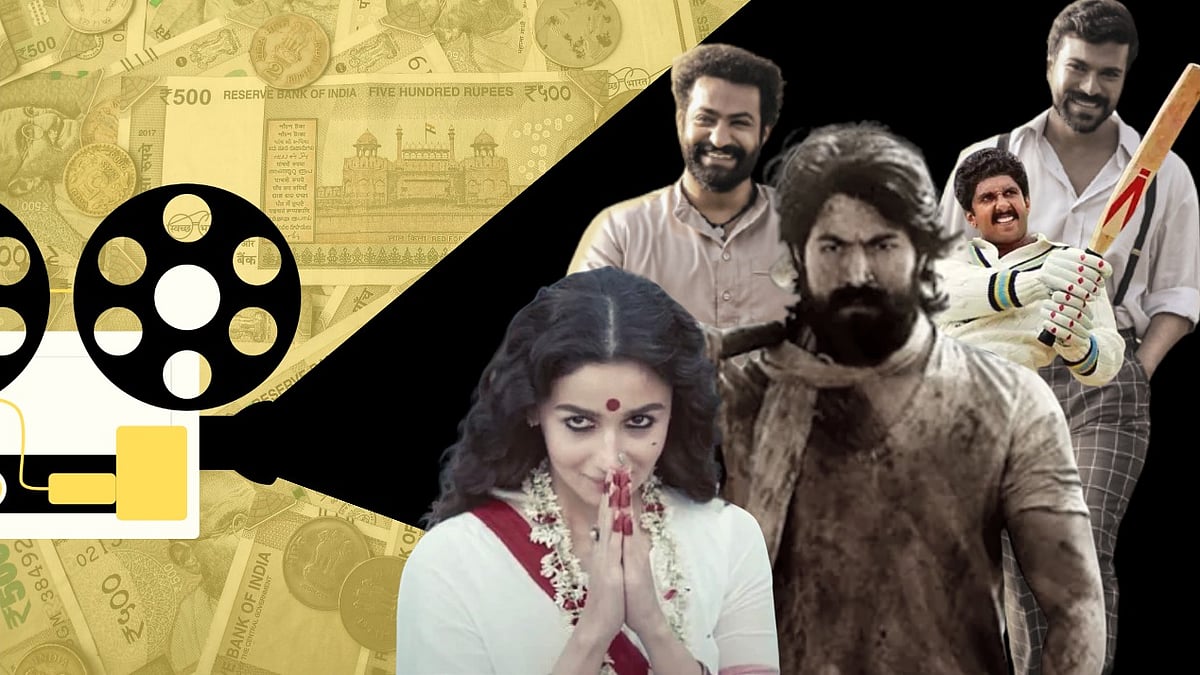Bollywood Is Feeling the Heat From South Cinema, Say Experts
Is South Cinema taking over the Hindi market? Bollywood needs to pull up the socks and carter to the masses too

advertisement
Yash starrer K.G.F: Chapter 2, the juggernaut from the Kannada film industry, released in five languages on 14 April and it was a record opener in the Hindi belt by raking in Rs 53 crore on day 1. The anticipation for the sequel was such that the makers of Jersey starring Shahid Kapoor reportedly moved their release date to 22 April to avoid a clash.
The film continues to break records, and going by the numbers the film is expected to dethrone SS Rajamouli’s RRR.
Post-pandemic, Allu Arjun’s Pushpa: The Rise raked in Rs 108.26 crore across India. When SS Rajamouli’s RRR released, the audiences thronged the theatres and it took the box office by storm, and the film earned Rs 240.79 crores in India.
Allu Arjun in Pushpa.
(Photo Courtesy: YouTube)
Be it Tamil, Telugu, Kannada, or Malayalam films, all of them have found an audience in the Hindi belt. Is it the larger than life-experience, content, or machismo that is working for them? The Quint spoke to industry experts to answer the big question- What is Bollywood not doing that they are being beaten at home ground?
Trade analyst and film producer Amul Mohan agrees with him and says films which are breaking box office records are a clear rehash of the 80s Bollywood films, “There is a lot of Deewaar and Kaala Patthar in KGF. Even the other films are taking from Bollywood films from the 80’s – I see a lot of Dharmendra films in them. They are working on heroism and hero worship and we are shying away from it; catering to only a certain type of audience.”
Can you imagine any other look of Yash in KGF?
(Photo Courtesy: Instagram)
He adds that a film can’t only strive and succeed on star power, it’s also the execution and content that translates into pan-India success.
Jeo Baby, the director of the critically acclaimed Malayalam film, The Great Indian Kitchen agrees with the sentiment, “I am not against superstars, but they must give more attention to the content. I think the criteria will change soon. We are in a phase shifting period. So, the audience needs better content not just star show.”
For instance, actor Salman Khan’s films used to send his fans into a frenzy and they would throng the theatres and set the box office ablaze, but that too has changed. Komal Nahta cites the ‘choice of subjects’ as a potential reason.
Nahta says, “It is not that his charisma has reduced. He is still the same Salman Khan who can give the audience their money’s worth. A lesser actor will do with a strong script but a weak script will not match up with a great actor.”
The Hindi film industry is facing competition in their own market from films down South. “Earlier it used to be an isolated incident and we could let it pass but now it’s a regular occurrence and we can’t let them slide anymore. Mani Ratnam’s Bombay, Jeans directed by S Shankar, SS Rajamouli’s Makkhi are a few examples of films that were dubbed in Hindi and did well in the Hindi belt, but we could count them on our fingertips, but the tide is now changing,” says Amul Mohan.
So, what has changed? Why do South films now have a clear edge over Bollywood?
“It’s thanks to the satellite channels, who have been dubbing South content into Hindi and they have built the audience. These actors are not new to them which has given the stars a big push making them household names. Actor like Rajinikanth and Kamal Haasan did not have this,” points out Komal Nahta.
Alia Bhatt in and as 'Gangubai Kathiawadi'.
(Photo Courtesy: YouTube)
Alia Bhatt-starrer Gangubai Kathiawadi did well, but the numbers didn’t come close to any of the South films that released recently. “They are giving the same content that we used to give our audience earlier but the South Films are doing it better. The presentation and execution of the content is refreshing and that is their genius. The dated style of presentation is not working and they have understood that. Earlier, you would not see a South Indian star give importance to North media but now they have realized their films are clicking and they are waking up to the fact that they need to promote it here too," adds Nahta.
If the current numbers are anything to go by K.G.F 2 which has already raked in Rs 275 crore in the first week, will surpass Dangal. It’s not a Bollywood film that will break a Hindi film’s record but a Kannada film.
“Bollywood, pull up your socks and stop over analysing. The audience wants masala, give it to them. Don’t just cater to a section of the audience but the masses too,” suggests Komal Nahta.
Whether it’s heroism, star power, content, marketing or the larger-than-life portrayal of characters, South Indian films have mastered the art of capturing audiences pan-India. We are not saying it, the numbers are.